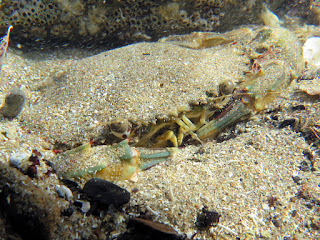 |
| Paratrophon cheesemani, Maori Bay, west coast of Auckland, March 2011. |
 |
| Paratrophon cheesemani, between green-lipped mussels, Maori Bay, west coast of Auckland, March 2011. |
Once these two forms are genetically analysed* they may turn out to be separate species.
Very little appears to be known regarding their ecology. However, Cheeseman's trophon is a muricid whelk and these whelks feed by boring through the shells of other animals (typically other gastropods, bivalves, and barnacles). My observations suggest that this species possibly fulfils a similar role to that of the oyster borer (Haustrum scobina (Quoy & Gaimard, 1833)), but lower on the shore, especially since vertical distributions of these two species don't appear to overlap. I suspect that this small gastropod is easily overlooked and the exposed nature of its habitat makes working on it difficult in situ.
*Barco et al. (2015) looked at P. cheesemani exsculptus but not P. cheesemani cheesemani, so no comparison was made between the two forms.
More info:
Barco A, Marshall B, Houart R, Olivero M. 2015. Molecular phylogenetics of Haustrinae and Pagodulinae (Neogastropoda: Muricidae) with a focus on New Zealand species. Journal of Molluscan Studies, 81(4): 476–488.
Paratrophon cheesemani http://www.mollusca.co.nz/speciesdetail.php?speciesid=1000&species=Paratrophon%20cheesemani
Paratrophon cheesemani exsculptus http://www.mollusca.co.nz/speciesdetail.php?speciesid=1001&species=Paratrophon%20cheesemani%20exsculptus






